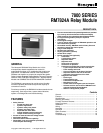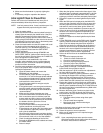
7800 SERIES RM7824A RELAY MODULE
65-0155—1
5
PRINCIPAL TECHNICAL FEATURES
The RM7824A provides all customary flame safeguard
functions while providing significant advancements in the
areas of safety, annunciation and system diagnostics.
Safety Shutdown (Lockout) Occurs If:
1. INITIATE PERIOD.
a. 24 Vdc power errors occurred, see Operation
section.
b. Configuration jumper has been changed (after
200 hours).
c. Four minute INITIATE period has been exceeded.
2. STANDBY PERIOD.
a. Flame signal is present after 40 seconds.
b. Ignition/intermittent pilot valve terminal is
energized.
c. Internal system fault occurred.
d. Main valve terminal is energized.
3. SAFE START CHECK.
a. Flame signal is present.
b. Ignition/intermittent pilot valve terminal is
energized.
c. Internal system fault occurred.
d. Main valve terminal is energized.
4. PILOT FLAME ESTABLISHING PERIOD (PFEP).
a. Ignition/intermittent pilot valve terminal is not
energized.
b. Internal system fault occurred.
c. Main valve terminal is energized.
d. No flame present at end of PFEP.
5. RUN PERIOD.
a. Ignition terminal is energized.
b. Internal system fault occurred.
c. Main valve terminal is not energized.
d. No flame present.
e. Pilot valve terminal is not energized.
SAFETY PROVISIONS
Internal Hardware Status Monitoring
The RM7824A analyzes the integrity of the configuration
jumper and internal hardware. The POWER LED will blink
every four seconds, signifying an internal hardware check.
Closed Loop Logic Test
The test verifies the integrity of all safety critical loads,
terminals 8, 9 and 10. If the loads are not energized properly;
i.e., the main valve terminal is powered during STANDBY, the
RM7824A will lockout on safety shutdown. The RM7824A
must react to input changes but avoid the occurrence of
nuisance
shutdown events. Signal conditioning is applied to
24 Vdc voltage inputs to verify proper operation in the
presence of
normal
electrical line noise such as transient high
voltage spikes or short periods of voltage dropout.
Dynamic Flame Amplifier and Shutter Check
Self-checking circuitry tests all electronic components in the
flame detection system and amplifier twelve times per minute
and shuts down the RM7824A if the detection system fails.
Dynamic Input Check
All system input circuits are examined to assure that the
RM7824A is capable of recognizing the true status of external
controls, limits and interlocks. If any input fails this test, a
safety shutdown occurs and the fault will be annunciated.
Dynamic Safety Relay Test
Checks the ability of the dynamic safety relay contact to open
and close. Verifies that the safety critical loads, terminals 8, 9
and 10, can be de-energized, as required, by the Dynamic
Self-check logic.
Dynamic Self-Check Safety Circuit
The microcomputer tests itself and related hardware, and at
the same time, the safety relay system tests the
microcomputer operation. If a microcomputer or safety relay
failure occurs and does not allow proper execution of the self-
check routine, safety shutdown occurs and all safety critical
loads will be de-energized.
Expanded Safe-Start Check
The conventional safe-start check, which prevents burner
start-up if flame is indicated at start-up, is expanded to
include a flame signal check during STANDBY and a safety
critical load check.
Off Cycle (Standby) Flame Signal Check
The flame detection subsystem (flame detector and amplifier)
is monitored during STANDBY. If a flame simulating condition
or an actual flame exists for 40 seconds in STANDBY, a safety
shutdown occurs and startup is prevented. If the flame signal
exists at any time after the 40 seconds during STANDBY, a
safety shutdown occurs and is annunciated. The self-checking
detector is energized for the first 40 seconds during
STANDBY and the last two seconds before exiting STANDBY.
If a flame exists after the first 40 seconds during STANDBY,
the self-checking detector is energized during the last ten
seconds of the 40 second flame detection period. If a flame
exists, a safety shutdown occurs.
Safety and logic timings are inaccessible and cannot be
altered or defeated.
Verified Spark Termination
The ignition terminal is monitored to assure early spark
termination (ten seconds ignition and pilot and ten seconds
pilot and main only)
.
First-Out Annunciation and Self-Diagnostics
Sequence Status Lights (LEDs)
provide positive visual
indication of the program sequence: POWER, PILOT, FLAME,
MAIN and ALARM. The green POWER LED blinks every four
seconds, signifying that the RM7824A hardware is running
correctly.
Optional multi-function Keyboard Display Module
shows
elapsed time during PILOT IGNITION. As an additional
troubleshooting aid, it provides sequence timing, diagnostic
information and historical information during normal operation
or when a safety shutdown or hold occurs.


















